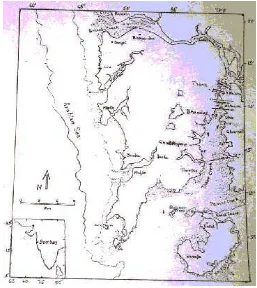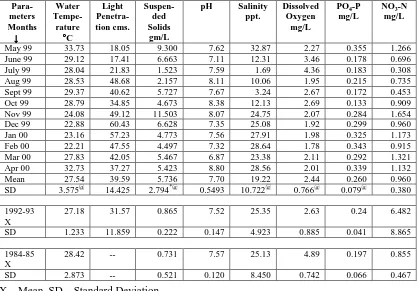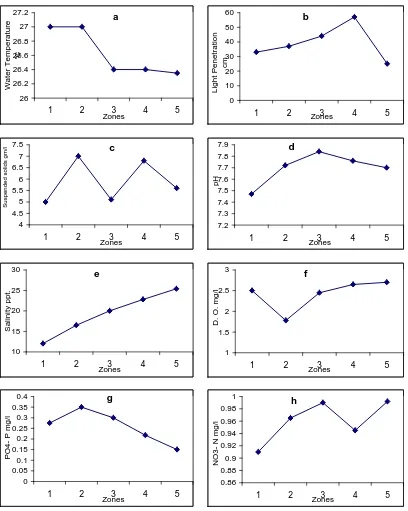Original paper
IMPACT OF CONSTRUCTION AND RECLAMATION ACTIVITIES
ON THE WATER QUALITY OF THE THANE CREEK,
CENTRAL-WEST COAST OF INDIA
Goldin Quadros*), Vidya Mishra, Mangal U. Borkar , R.P.Athalye
Zoology Department, B. N. Bandodkar College of Science, ‘Dyandweep’ Chendani, Thane 400 601, India
Received: September 5, 2003 ; Accepted: January 15, 2004
ABSTRACT
Degradation of natural resources is a major environmental issue the world is currently facing. Estuaries, creeks and coastal water ecosystems are such natural resources that are important as breeding and feeding grounds for fishes and crustaceans. Human activities and alterations made by reclamation have had an adverse effect on their ecology. Due to this, water quality management in these ecosystems has become a necessity. Regular studies of the hydrological parameters are essential for this purpose, as they can assess the status of pollution and help in deciding the mitigation strategy.
Water quality of 26 km stretch of Thane creek, central-west coast of India was analyzed in 5 regions of the creek from May 1999 to April 2000. The study revealed spatial and temporal patterns. Heavy suspended solid load (avg. 5.736 gm/L), frequent hypoxia (DO<2.5 mg/L) coupled with excess nutrients like Phosphate-Phosphorus (avg. 0.26 mg/L) and Nitrate-Nitrogen (avg. 0.96 mg/L) were the main features of the creek.
The Thane city region showed more deterioration of water quality compared to the other regions in the creek. In this region the suspended solid load showed an increase of 713.69% and dissolved oxygen decreased by 21.55% compared to the data of 1992-93. This can be attributed to the severe onslaught of activities in this region like solid waste dumping, construction of 3 new bridges, etc. since 1993, thereby affecting the flushing characteristic. Hence in order to protect and preserve such ecosystems, alterations to the environment should be meticulously planned.
Key words: Thane Creek-India, hypoxia, reclamation activities, increased nutrients and suspended
solids.
Correspondence: Phone: 022-25336507; Email: goldinq@yahoo.com
I
NTRODUCTION
Estuaries and creeks are coastal bodies of water that have a free connection with the open sea. They are strongly influenced by the tidal action and land drainage. The presence of mangroves along the mudflats
drawback and they are being used indiscriminately for dumping large quantities of solid wastes, sewage and industrial effluents.
Thane creek on the central-west coast of India (Long. 72° 55’ to 73°.02’ E and Lat. 19°.00’ to 19°.15’ N) is one such ecosystem, which suffers the consequences of heavy industrialization and urbanization that has occurred along its banks. The creek has on its east bank, Thane-Belapur industrial belt, the biggest in Asia and Navi Mumbai residential complex, whereas on the west bank it has highly populated Thane-Mumbai residential complex and a good number of industries as well. This has increased human aggression in this area causing stress on the ecosystem. The aggression is not only in the form release of sewage and industrial wastes in the creek but it is also in the form of dumping
of solid waste garbage and reclamation activities for different purposes. The deterioration caused by these activities can be easily indicated by short term and long- term studies of water parameters. The present study shows how unplanned construction and reclamation activities add to the deterioration of water quality.
M
ATERIALS AND
M
ETHODS
Study area
The study was conducted in the 26 Km. stretch of Thane creek from May 1999 to April 2000. For investigation the creek was divided into 5 regions (zones) as follows (Fig. 1).
Fig. 1. Map showing Thane creek and Study stations (1 to 12).
1. Riverine zone: The shallow and region receives effluents from chemical and fertilizer industries apart from domestic sewage.
4. Bombay city zone: This 7 Km. stretch is broad and deeper part of the creek receiving effluents from Navi Mumbai and Mumbai city.
5. Seaward zone: This is the southern end of the creek with the stretch of 6 Km. that has maximum influence of the Arabian seas.
Water sampling
Depending on the length of the zone water samples were collected from 4 to 8 places in the zone every month during high tide and low tide using clean plastic buckets.
Measurement of hydrological para-meters
Water temperature was recorded in the field using alcohol thermometer, while light penetration was observed using Secchi’s disc in the field. The parameters like salinity, dissolved oxygen, suspended solids, phosphate-phosphorus (PO4-P) and nitrate-nitrogen (NO3-N) were analyzed using ‘Standard Methods’ (APHA, AWWA, WPCF, 1981).
Data analysis
Statistical tests of significance were used for comparing the data. Comparison between the low tide and high tide averages were made wherever necessary. However in most cases the difference between them being insignificant, overall
averages were calculated to prepare monthly and zone wise data.
R
ESULTS AND
D
ISCUSSION
The averages of hydrological parameters of Thane creek showing monthly variations are shown in Table 1; while the zone wise spatial variations of the creek are presented in Figure 2.
Water temperature exhibited wide fluctuations in between 21°C to 35.25°C (avg. 27.5°C). The overall wide range of temperature can be attributed to shallowness of the creek. Mainly the atmospheric temperature governed the water temperature. The minimum temperature was observed in winter (December) while the maximum was recorded in summer (May). Spatial comparison revealed warmer waters in the shallow riverine and Thane city zone, whereas the deeper downstream stretches of the creek were comparatively cooler.
Table 1. Monthly averages of the hydrological parameters of Thane creek.
Para-meters Months ↓↓↓↓
Water Tempe-rature
°°°°C
Light Penetra-tion cms.
Suspen-ded Solids
gm/L
pH Salinity ppt.
Dissolved Oxygen
mg/L
PO4-P mg/L
NO3-N mg/L
May 99 33.73 18.05 9.300 7.62 32.87 2.27 0.355 1.266
June 99 29.12 17.41 6.663 7.11 12.31 3.46 0.178 0.696
July 99 28.04 21.83 1.523 7.59 1.69 4.36 0.183 0.308
Aug 99 28.53 48.68 2.157 8.11 10.06 1.95 0.215 0.735
Sept 99 29.37 40.62 5.727 7.67 3.24 2.67 0.172 0.453
Oct 99 28.79 34.85 4.673 8.38 12.13 2.69 0.133 0.909
Nov 99 24.08 49.12 11.503 8.07 24.75 2.07 0.284 1.654
Dec 99 22.88 60.43 6.628 7.35 25.08 1.92 0.299 0.960
Jan 00 23.16 57.23 4.773 7.56 27.91 1.98 0.325 1.173
Feb 00 22.21 47.55 4.497 7.32 28.64 1.78 0.343 0.915
Mar 00 27.83 42.05 5.467 6.87 23.38 2.11 0.292 1.321
Apr 00 32.73 37.27 5.423 8.80 28.56 2.01 0.339 1.132
Mean 27.54 39.59 5.736 7.70 19.22 2.44 0.260 0.960
SD 3.575@ 14.425 2.794*@ 0.5493 10.722@ 0.766@ 0.079@ 0.380
1992-93 X
27.18 31.57 0.865 7.52 25.35 2.63 0.24 6.482
SD 1.233 11.859 0.222 0.147 4.923 0.885 0.041 8.865
1984-85 X
28.42 -- 0.731 7.57 25.13 4.89 0.197 0.855
SD 2.873 -- 0.521 0.120 8.450 0.742 0.066 0.467
X – Mean, SD – Standard Deviation
* - Statistically significant change with respect to 1992 - 93 data at 10% level of significance. @-Statistically significant change with respect to 1984 - 85 data at 10% level of significance.
Suspended solids ranged from 0.200 to 39.600 gm/L (avg. 5.736 gm/L), which were significantly high as compared to other Indian estuaries (Nair et al., 1987; Reddy et. al., 1994). The minimum suspended solids during monsoon can be attributed to dilution while the high and
a
A comparison between high tide and low tide data revealed higher suspended solid load during low tide. But in the Thane city zone the suspended solid concentration increased by 24% during high tide. This suggested poor flushing and accumulation, which can be attributed to increased human activities like solid waste and garbage dumping, construction of bridges and other reclamation activities in this zone in the past few years. Present data shows 713.69% increase in suspended solids in Thane city region when compared to the data of 1992-93 (Quadros, 1995), which was collected prior to the construction of bridges and reclamation activities. The difference is statistically significant.
The pH was alkaline in Thane creek with an average of 7.7 and ranging from 6.86 to 9.20. It showed minor temporal and spatial variations. Salinity in the estuarine system is largely influenced by the influx of freshwater and the intrusion of seawater (Anirudhan and Nambisan, 1990). Hence the estimation of towards the seaward zone. Average salinity 12.08 ppt. of the riverine zone and overall average of 19.22 ppt. indicate dominance of tidal marine water in the creek (Fig. 2). However it was apparent that the overall average of the present study was significantly lower than the average salinity of 25.13 ppt. recorded in 1984-85 (Athalye, 1988; Annie Mathew, 1989) and 25.35 ppt. of 1992-93 (Quadros, 1995). This could be due to two reasons 1) increased load of effluents, which contains more freshwater 2) reduced flow of tidal
marine water probably due to hindrances caused by different reclamation and construction activities in the creek. The second reason indirectly suggests hampered flushing characteristic.
Dissolved oxygen ranged from 0.3 to 6.17 mg/L (avg. 2.44 mg/L). Dissolved oxygen is used as an index of water quality (Adney, 1908). According to Laponite and Clark (1992), dissolved oxygen less than 2.5 mg/L indicates hypoxic conditions. In the present study, except for a few high values observed during monsoon the creek water was hypoxic indicating heavy pollution in the creek. Dissolved oxygen improved from the riverine to the seaward end, but Thane city zone had the lowest average dissolved oxygen (1.82 mg/L). When compared with the dissolved oxygen averages of 1992-93 (Quadros, 1995), The Thane city zone showed 21.55% reduction while the rest of the creek showed 7.22% reduction. This suggested higher degree of deterioration in the Thane city zone due to different anthropogenic activities mentioned earlier.
Phosphorus is the nutrient that regulates the production in aquatic ecosystem. In the present study PO4-P
varied between 0.13 to 0.472 mg/L with an average of 0.26 mg/L, which is high as compared to other Indian estuaries. According to Fisher et.al. (1988) industrialisation and urbanization of land and coastal water ways lead to widespread increase in phosphorus. In Thane creek the values below 0.08 mg/L, the limit for unpolluted waters as suggested by Yentsch and Ryther (1957) were rarely observed. Most Indian estuaries experience rise in PO4-P during monsoon due to influence of
freshwater, while Thane creek showed dilution and low values of PO4-P.The
spatial comparison revealed a reduction in PO4-P concentration from the riverine to
seaward zone, except for Thane city zone where accumulation of PO4-P was
Nitrate – Nitrogen was in the range of 0.251 to 2.539 mg/L (avg. 0.96 mg/L). The minimum was observed during monsoon and peak during post-monsoon. The nitrates in Thane creek are much high as compared to other Indian estuaries and show wide fluctuations. Varshney et.al. (1987) has reported NO3-N upto 315 mg/L
for Thane creek attributing them to effluent release, whereas Quadros et.al. (1994) recorded exceptionally high values and unpredictable fluctuations of NO3-N in
Thane creek due to some effluent source in the downstream region. Probably due to this reason the present data showed lower NO3-N than 1992-93. The comparison
between the different zones indicates the source of Nitrate to be in the middle zone of the creek, which had high nitrates during both high tide and low tide.
C
ONCLUSION
In the present study hypoxia and build up in suspended solid load and nutrients were observed in Thane creek, revealing poor water quality of the entire creek. But the deterioration was more pronounced in the Thane city zone. This can be attributed to the anthropogenic activities such as building of bridges, land reclamation and solid waste dumping which increased since 1993 in this zone.
The human aggression apart from affecting the water quality has also significantly lowered the fishery of the creek. Presently the fishing activity has got shifted to the downstream areas of the creek, as the sporadic fishing activity in the Thane city zone yields only 3 fishery species. In the downstream stretches only 8 fishery species are commonly observed, which indicates decline in the species number in the downstream region as well. Thus in order to protect the Thane creek ecosystem it has become necessary to plan
the human activities meticulously. Further taking Thane creek as an example the freshwaters: I. Application of aeration method of analysis to the study of river water” Royal
commission, Fifth report, Appendix, 7: 95.
Anirudhan,T.S. and Nambisan, P.N.K. 1987. Distribution of salinity and silicon in cochin estuary. Indian J.
Mar. Sci. 19: 137 – 139.
APHA, AWWA, WPCF., 1981.
International standard methods for the examination of water and waste water. 15th edition, Washington D.C. 874 pp.
Athalye R.P. 1988. Status of macrobenthos
in detritus food chain of Thane creek near Thane city. Ph.D.
Thesis, University of Bombay. 197 pp.
Fisher, T.R., Harding, L.W. Jr., Stanley, D.W. and Ward, L.G., 1988. Phytoplankton, nutrients of turbidity in the Chesapeake, Delaware and Hudson estuaries.
of Environment and Forests, Government of India. 40 pp.
Gordan, H.R.; Smith, J.M. and Zaneveld, J.R.V., 1980. Introduction to ocean optics. SPIE Ocean. Optics. IV. 208 : 14 – 55.
Laponite, B.E. and Clark, M.W., 1992. Nutrient inputs from the water shed and coastal eutrophication in the Florida keys”. Estuaries. 15 (4): 465 – 476.
Mathew, A. 1989. Marine benthos of the
creek and coastal environments of Bombay. Ph.D. Thesis, University
of Bombay. 138 pp.
Mitra, A.; Patra, K.C. and Panigrahy, R.C. 1990. Seasonal variations of some hydrographical parameters in a tidal creek opening into the Bay of Bengal”. Mahasagar- Bull. Natl.
Inst. Oceanogr. 23(1): 55–62.
Nair, M.N.M.; Harish, C.M. and Premchand, K. 1987. Vertical suspended sediment distribution in Beypore estuary”. Procc. Natl.
Seminar on Estuarine Management, Trivandrum. 38 –
43.
Odum, E.P. 1971. Fundamentals of
Ecology. W. B. Saunders Company. Philadelphia. PA 19105.
Pomeroy L.R. and Kuenzler, E.J. 1969. Phosphorus turnover by coral reef animals. Procc. 2nd Symp on radio ecology. (ed) Nelson and Evans
U.S. Atomic energy commission. 474 – 482.
Quadros, G. 1995. Study of hydrological
parameters of Thane creek. M.Sc.
Thesis, University of Bombay. 202 pp.
Quadros, G., Gokhale, K.S., Athalye, R.P., Ullal, V., Mishra, V. 1994. Mitigation strategy to reduce eutrophication in the shallow region of Thane creek. Procc. 3rd
Natl. Symp on environment.
Thiruvananthapuram. 251 – 253.
Reddy, N.P.C., Rao, B.P., Rao, K.M. and Rao, V.S. 1994. Seasonal changes in suspended sediment load in the Gauthami-Godavari estuary.
Mahasagar-Bull. Natl. Inst. Oceanogr. 27 (1): 47 – 53.
Varshney, P.K., Govindan, K. and Desai, B.N. 1987. Meiobenthic study of polluted Thana creek, Bombay. J.
Hydrobiol. 3 (5): 9 – 15.


